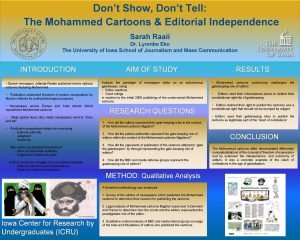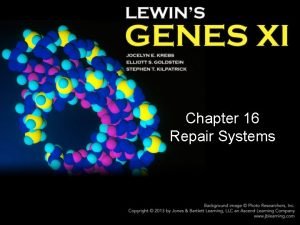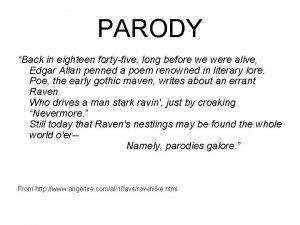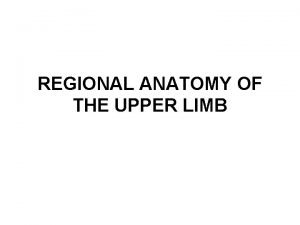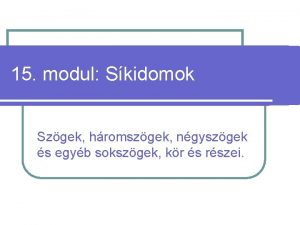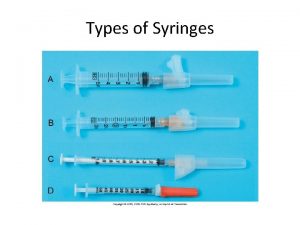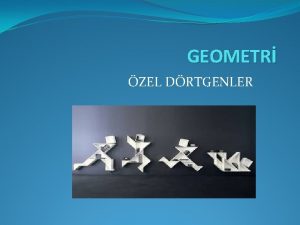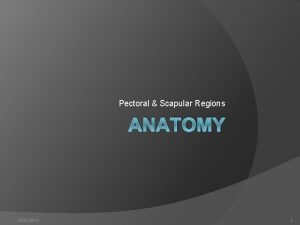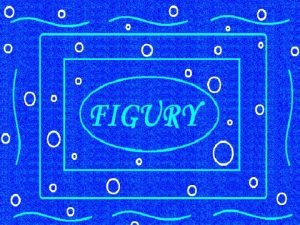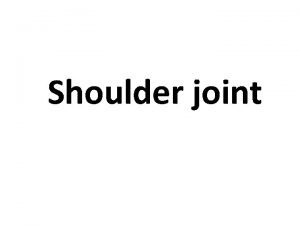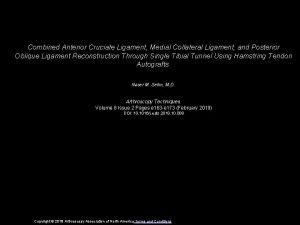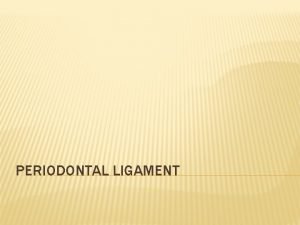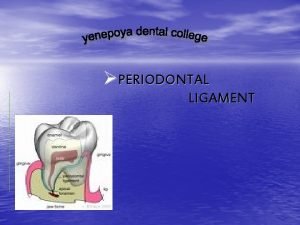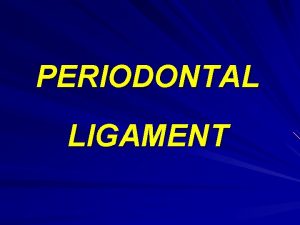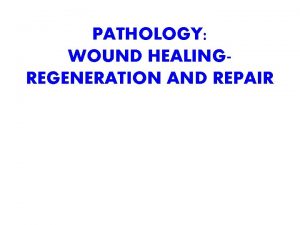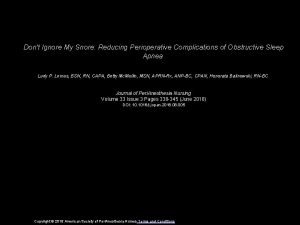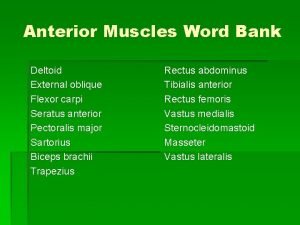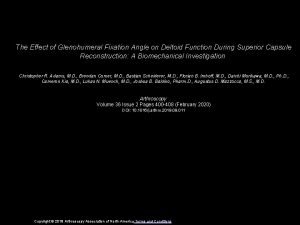Deltoid Ligament Repair Dont ignore when to repair




















- Slides: 20

Deltoid Ligament Repair: Don’t ignore & when to repair Paul E. Matuszewski, MD Director, Orthopaedic Trauma Research Assistant Professor Orthopaedic Traumatology Department of Orthopedic Surgery and Sports Medicine University of Kentucky College of Medicine

Disclosures • No relevant disclosures

Background • Deltoid ligament plays role in maintaining medial tether of talus during motion • Deltoid ligament consists of two components – Superficial – Anterior, restraint to hindfoot eversion – Deep – Primary restraint to external rotation (Valgus tilt requires both superficial/deep disruption)

Background Cont. • In rotational ankle fractures…. – Two options for medial sided injury: • the medial malleolus fails (e. g. fracture) • deltoid ligament tears • When the deltoid tears – Typically injury represents an avulsion type injury from the medial malleolus

Diagnosis? • Physical exam? => Not helpful (De. Angelis et al JOT 2007) • MRI? => Too much variability (Nortunen et al JBJS 2014) • Xrays? => Sometimes… – An asymmetrical mortise e. g. A wide medial clear space (>4 mm, or >1 more than tibiotalar clearspace), is considered “unstable” (Baird et al JBJS 1987, Park et al JOT 2006) • Stress exam => better (dynamic exam, vs static) – For lateral malleolus fractures which have a symmetrical mortise, stress radiography helps discern “stability”. E. g. Deep deltoid tear

The Injuries • Bimalleolar equivalent w/ syndesmotic injury • Also trimalleolar equivalent, high fibula fracture, etc.

The Question? • Why? • If = Unstable = Fix Medial + Lateral • Also…. unstable • Both medial lateral constraints “broken” • Why not repair deltoid, just like medial malleolus? ? ?

Background Cont. • 1972 – Weber recommended exploration and repair of deltoid ligament – Often Interposed fibers of deltoid can prevent anatomic reduction • Exploration makes intuitive sense: – If “stuff” in the joint => get it out • What about repair? ?

Anti-Repair Camp • Some earlier studies suggested repair not necessary. . • If you fix lateral side, medial side will ‘scar in’ • Baird et al 1987 – repair vs no repair (3 repairs, 21 no repair) 90% of no repair group did well – – Not really a fair comparison Harp et al Clin Orthop Rel Res 1988 De Souza et al JBJS 1985 Zeegers et al Injury 1989 • Later down the road… • Stromsoe et al 1995 – Randomized trial, no difference between the groups – …but was it powered? ? • Maynou et al 1997 – Retrospective Comparative study 18/17 No difference if mortise restored

The Whole Story? • What about residual instability? • Remember: Even 1 mm instability can result in 42% reduction of contact area (Ramsey et al JBJS 1976) • Is the followup…not enough? • Zeegers 1989 Injury: 28 fractures treated without medial repair – 25% (7/28) developed osteoarthritis…but asymptomatic, so concluded…not important • Johnson et al 1988 – Residual medial sided tenderness • Some patients in early studies didn’t do so well… what about those patients? ?

Repair It’s the 2000’s No repair

Evidence Starts to Surface… • Hsu et al 2015 Foot ankle Int – NFL players return to play 86% with deltoid repair • Yu Guang-rong et al 2015 Foot and Ankle Surg. 4 Centers, retrospective, 106 pts, AOFAS, VAS, SF-36 better with deltoid repair and no instability • Gu et al Int J Clin Exp Med 2017 – 40 pts, randomized trial. Better AOFAS, decreased VAS with repair • Zhao et al 2017 BMC Musculoskelet Disord – Retrospective comparison review: 74 patients, decreased medial clear space, malreduction

More Early Evidence • Woo et al Foot Ankle Int 2018 – Comparative: 78 patients repair vs not repair – Patients with concomitant syndesmotic injury and deltoid repair had superior AOFAS, VAS, medial sided pain • Jones et al JOT 2018 – Retrospective, 27 patients, Deltoid repair rather than syndesmosis => similar functional, similar radiographic results • Schottel et al 2016 JOT – Cadaveric study – ligamentous repair has equivalent restoration of rotation to syndesmosis repair

Biomechanical Evidence • Butler et al 2019 – ORIF +/- repair – repair restores normal motion

Deltoid repair? • Review of the literature: – A large number of “conservatively” treated deltoid injuries do well… BUT NOT ALL (29%, roughly) – Not everything is black and white – However…perhaps not all of these scar in the right place • Leading to: – Residual instability? – Medial Gutter pain? – Post traumatic arthritis?

So When to Fix? • Is there an injury pattern to identify? – Maybe – Woo et al 2018 – Injuries with concomitant syndesmotic injuries do better with repair • Residual instability following fixation. . • Clearly something else going on…

Now What? ? • Just… let it scar? Chances of scarring correctly? • Following a treatment algorithm can help identify these possible “Bad actors”

Recommended Sequence • Fix lateral malleolus • Restoration of mortise? – No => critically assess reduction and possibly check medial side • Assess syndesmosis for instability (Cotton, ER stress) – Fix if need be • Reperform stress exam to assess for instability +/- talus tilt test – If positive, repair

Summary • Deltoid injuries can often be treated “conservatively” • However, a subset of patients have persistent issues • Likely related to latent instability • Repair of the deltoid following fracture fixation in persistently unstable fractures can improve markers of instability, medial sided pain and possibly clinical outcome

Thank you
 Dont ask dont tell political cartoon
Dont ask dont tell political cartoon Don't laugh at me allen shamblin
Don't laugh at me allen shamblin Depurination
Depurination Mismatch repair
Mismatch repair Classless css
Classless css Rhyme scheme of a tiger in the zoo
Rhyme scheme of a tiger in the zoo Dmca ignore server
Dmca ignore server Abort retry ignore poem
Abort retry ignore poem Improve üçüncü hali
Improve üçüncü hali A programmer can choose to ignore an unchecked exception.
A programmer can choose to ignore an unchecked exception. Diagonale deltoid
Diagonale deltoid Nervus interosseus antebrachii posterior
Nervus interosseus antebrachii posterior Sokszög belső szögeinek összege
Sokszög belső szögeinek összege Deltoid tuberosity
Deltoid tuberosity Vastus lateralis injection
Vastus lateralis injection Wielokąt wklęsły
Wielokąt wklęsły Yamuk köşegen
Yamuk köşegen Deltoid četverokut
Deltoid četverokut Deltoid tuberosity
Deltoid tuberosity Deltoid wpisany w okrąg
Deltoid wpisany w okrąg The clavicle and the scapula form the
The clavicle and the scapula form the
